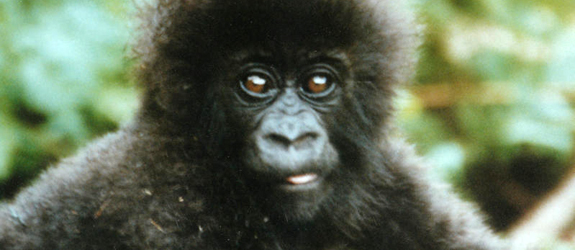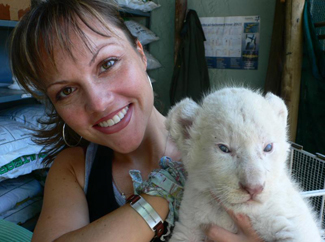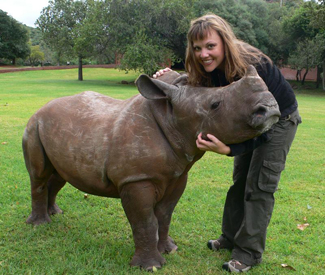
Gorilla Facts
- Each gorilla has a distinctive fingerprint and a distinctive noseprint.
- Adult male gorillas eat about 45 pounds of food per day; females typically eat about two thirds of this amount.
- Female gorillas in the wild can give birth every four years; gorillas in the zoo can give birth every two to three years.
- After chimpanzees, gorillas are humans’ closest relatives, sharing about 98 percent of human genes.
- Gorillas typically live about 35 years in the wild and up to 54 in a zoo.
- Most zoo gorillas are Western lowland gorillas.
(From Smithsonian National Zoo and the San Diego Zoo)
What the poachers started, a sneeze could finish.
As more people journey to Africa to catch a glimpse of this endangered species in the wild, the risk of spreading even mild human infections to the gorilla population grows. Although tourism may not be nearly as dangerous to the future of the gorilla as poaching or forest destruction, it does carry many risks.
“The important thing to note is that to a human, a cold may not be a big deal, but when introduced to these animals who happen to be in danger, something as simple as a cold could literally wipe out the population of a gorilla, because they’re not exposed to these germs,” explains Hayley Adams (UT CVM ’01).
Adams, who received a doctorate in comparative and experimental medicine from the College of Veterinary Medicine in 2008, witnessed the medical problems facing gorillas firsthand when she traveled to Uganda during veterinary school. Her desire to help improve veterinary care and conservation efforts for gorillas and other endangered animals led her to create her own nonprofit organization, the Silent Heroes Foundation, which was launched in summer 2010. The Georgia-based foundation collects money for supplies crucial to preserving animal health, such as veterinary equipment and items like face masks, which help prevent the spread of disease between humans and gorillas. It also accepts direct donations of veterinary supplies.
 “I was looking for a way to fill a niche and make a difference in wildlife conservation efforts in Africa,” she says.
“I was looking for a way to fill a niche and make a difference in wildlife conservation efforts in Africa,” she says.
The funds and supplies are distributed by the foundation to a variety of veterinary, educational, and conservation groups in Africa, including the Mountain Gorilla Veterinary Project, a rhinoceros protection project in South Africa, and an elephant orphanage in Zambia, as well as domestic animal veterinarians, such as David Hyeroba.
The receipt and distribution of supplies and funds is handled by Adams’s partner, Innocent Rwego, who is based in Uganda. Adams met Rwego, who is also a veterinarian, when she was conducting research in Uganda, and when she decided to start a nonprofit, he was happy to partner with her. In addition to managing the supplies and funds on the ground, Rwego visits the projects and reports his observations and recommendations to Adams. Married with two children, Adams says she cannot travel to Africa as often as is necessary, so Rwego’s role is crucial.
“Not everybody can be on the front lines. I have an interest in wildlife throughout Africa and would love to be on the front lines, but it’s just not feasible,” she says.
OVEREXPOSURE
 There are approximately 780 mountain gorillas alive today, all of which are living in the wild (the gorillas found in zoos are lowland gorillas, a different subspecies). The animals are found in mountainous areas in Uganda, Rwanda, and the Democratic Republic of Congo. The International Union for Conservation of Nature (IUCN) has classified the mountain gorilla as a Critically Endangered animal, noting that the significant population reductions of the past 20 to 30 years are not easily reversible.1
There are approximately 780 mountain gorillas alive today, all of which are living in the wild (the gorillas found in zoos are lowland gorillas, a different subspecies). The animals are found in mountainous areas in Uganda, Rwanda, and the Democratic Republic of Congo. The International Union for Conservation of Nature (IUCN) has classified the mountain gorilla as a Critically Endangered animal, noting that the significant population reductions of the past 20 to 30 years are not easily reversible.1
“Once they’re gone, that’s it. So it’s really important that we step up now,” Adams says.
There are numerous threats to the long-term survival of the mountain gorilla. According to the IUCN, illegal poaching activities in 2007 led to a population loss of 1 to 2 percent, and poaching continues to be a problem.1 Civil unrest and military activity in certain regions have led to animal deaths, as has the expansion of the human population into gorilla habitats. Preservation efforts have helped enlarge the gorilla population, but such gains are fragile and could be wiped out easily by poachers or other human threats like disease.
In good news, movies, education campaigns, and gorilla tours have raised awareness of the dangers gorillas face. Gorilla tourism, while considered to have an overall positive effect on gorilla efforts, has been a mixed blessing, Adams says. On the one hand, tourism has educated a large number of people about gorillas and has been crucial in raising funds for veterinary and conservation projects. On the other hand, the humans who visit the area can easily transmit diseases to the animals, who like to get close to their visitors. Because the gorillas have largely never come into contact with many human diseases before, their immune systems are not equipped to handle them, meaning that even mild infections could be fatal. A simple cough or sneeze could sicken an entire community of gorillas.
“There’s definitely a risk of several diseases—respiratory diseases, colds, influenza, things that could cause pneumonia, especially when people have symptoms like coughing,” Adams says, adding that other communicable diseases, like certain intestinal infections, also are a problem. Luckily, disease transmission is preventable, and Silent Heroes aims to work hard at eradicating it.
SILENT HEROES
Preventing disease transmission between humans and gorillas is a key part of Silent Heroes’ mission. Adams says that inexpensive items like face masks ($2.50 for a box of 50 masks) can go a long way toward preserving animal health, and her foundation purchases boxes of masks and bottles of hand sanitizer to send to the groups working with gorillas. Using these simple precautions, she notes, can make a huge impact in wildlife conservation.
“We really need donations just to purchase things like face masks and hand sanitizer,” she says. “That is a great way and an easy way for anybody to contribute directly to gorilla conservation.”
Although much of the foundation’s work is with gorilla-focused organizations, it also partners with veterinary universities and governmental organizations in Africa, projects related to rhino and elephant conservation, and efforts to support veterinary medicine in impoverished areas where the lack of proper supplies is a big issue.
“We have a vested interest in gorillas and chimps, especially gorillas, because of my background and because they are in dire need right now, but we certainly don’t discriminate. We’re open to helping vets who work with many types of species,” Adams says.
Meanwhile, she urges donors to consider giving to gorilla preservation efforts, because the animals need all the help they can get, and even small donations can have a large positive impact.
“I’m passionate about donating to this cause because it’s something simple that anybody can do to make a difference,” Adams concludes.
To learn more about Silent Heroes or to make a donation, go to www.thesilentheroes.org. Donations are tax-deductible to the extent allowed by law.
11IUCN Red List: Robbins M, Williamson L. 2008. Gorilla beringei. In: IUCN 2010. IUCN Red List of Threatened Species. Version 2010.3. Available at: www.iucnredlist.org. Accessed October 21, 2010.
